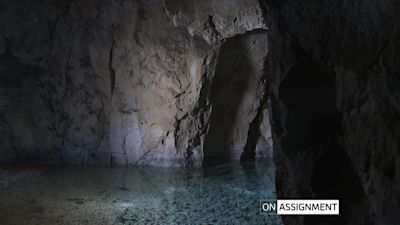Why are the many layers of history hidden beneath modern Rome causing a problem?

An old iron staircase and a few rough steps lead down to what looks like a cave. We are in the centre of Rome, a short distance from the Colosseum.
Over our heads are great stone slabs which once formed a corner of the enormous Temple of Claudius. On top of those sits a convent.
But what lies beneath it isn’t a cave. It’s a quarry.
Someone has bricked up the sides of the entrance to form a rudimentary doorway. Water drips from the ceiling. We flick on powerful torches on our helmets as Marco Gradozzi from Subterranean Rome guides us in.
Down one gallery there are two small lakes. The earth on the floor is uneven and Marco tells me it was deposited there by Napoleon’s men when they excavated the Colosseum. What’s even more fascinating is that the Temple of Claudius was not built on top of the quarry - the quarry was excavated from under the Temple.
Modern Rome sits on top of many layers of history, some of it famous but much of it forgotten. And these layers contain catacombs, cisterns, sewers and quarries. The quarries were mostly created for the extraction of ‘tufa’ - a versatile building material.
But the location of many quarries has been forgotten over the years and now they are a problem. The increasing weight of traffic on Roman roads, including ever more heavy modern vehicles, is putting pressure on these underground spaces like never before. And the incidence of sinkholes has risen rapidly.
Although the sinkholes themselves can start out small, the spaces beneath them can be cavernous. Adriano Morabito from Subterranean Rome takes us into a sinkhole that opened up between a block of flats and a playground. It’s now awaiting repair and full of scaffolding.
Underground, the problem is familiar - a tufa quarry which stretches out under the surrounding area. The builders of the flats knew it was here and put in the necessary foundations. But then they closed it up.
Adriano and his colleagues are commissioned by the city authorities to map these spaces when they appear. Other teams use ground penetrating radar to locate spaces that haven’t yet opened into sinkholes.
But finding weak spots is only a partial solution; getting Romans out of their cars is the real answer. Better public transport would help, but it’s difficult in Rome. The city’s metro system is one of the shortest in Europe. The problem says former Transport Minister Alessandro Bianchi is, once again, Rome’s heritage.
Every time the tunnellers start digging a new line they discover more archeological remains and have to stop for proper excavation work. Alessandro says the construction of one metro station was so beset by archeological delays that it took 10 years to build.
So until some kind of overground mass transit system can be agreed and built, Rome and the Romans remain at the mercy of their wonderful history and their terrible traffic.
Watch On Assignment on ITV at 10.50pm on Tuesday November 30.